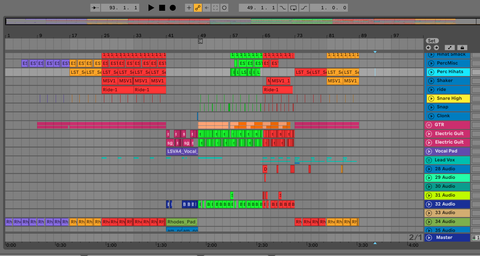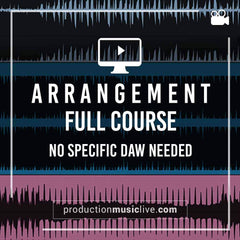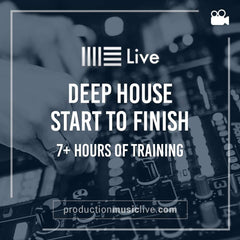
Are you struggling with finishing your tracks? Do you have a habit of getting tired of your track half-way through, putting it to rest in your unfinished project graveyard? You’re not alone. This is a destructive habit many producers get in to, and many assume this is just the way it is.
But don’t worry, there are four very simple steps you can take to finally start finishing your tracks. It’s just a matter of discipline, letting go of control and enjoying yourself more. Doesn't sound too bad, does it?
Finishing tracks is easy, once you enter the right mindset and develop the right workflow. In this article we’ll get into how having deadlines and vision, leaving your mixing to the end and stopping perfectionism will make finishing tracks a breeze.
Let’s get into it.
1. Have a Vision

The main reason why you can’t finish your tracks, why you have a graveyard of unfinished projects, is simple. Your tracks lack vision.
But what do I mean by a vision and why do you need to have it?
Music Is A Story
Well, first you need to remind yourself music is a story. It has a beginning, middle and an end. Like the words and sentences in a book, the notes, melodies, and sounds create a sonic plot, taking the listener on potentially incredible journeys.
The best music is created when the producer is clear about the where, what and how’s of the track. Unfocused production can be heard (when the producer manages to finish and upload their track). It sounds confusing, unpassionate and without heart.
But don’t worry, there are easy steps you can take to make sure you have a vision. The first step to starting to finish your tracks.
Do Like The Master Producers
Whether consciously or subconsciously, all master producers have some kind of vision when producing. Without it, there isn’t an end-goal and your tracks just end up in the unfinished graveyard pile of your harddrive.
To give yourself a vision to your track…
Ask yourself these three questions:
a) Where is the track taking place?

Having a setting, or an idea of the soundstage for your track when you start is key. Where do you want to take the listener?
You have endless choices here.
When you close your eyes and listen to your favorite music, it’s like you get transported to another world.
Where Does Music Take You?
If it’s a tropical track you listen to, you can almost smell the salty ocean breeze, taste the cold, fresh mojito’s and hear the waves crashing on the beach.
An electronic dubstep track can sound like an alien war, and a crusty Lo-Fi beat sounds like it’s playing out of a warm room in the attic.
When you know where your track takes place, sound selection, mixing choices and everything will become a lot easier.
You also need to know where your track will go. What’s the end goal and what do you want to convey to your listener?
A Story Example
For example, let’s say you created a track called “Bad Day At The Beach”.
You could start the track off happy and upbeat, with layered atmospheres of children laughing, Polynesian percussion, crashing waves and lush tropical guitars. The track could later fall into a deep, dark pit of despair when disaster strikes your imaginative beach.
Your track would have a clear purpose and story, be easier for you to produce and take your listener through your mind and heart.
How the story plays out in the listener's head is another story, and that's what's so fascinating about music. No two people interpret a musical piece the same.
b) What instruments and sounds are you going to use?

Knowing what type of instruments and sounds to use helps tremendously in finishing tracks. When you’re clear about where your track takes place, you need to figure out what instruments and sounds are going to help you get there.
No, you don’t need to know by heart, exactly which sounds to use. Making music is an experimental process, sometimes you decide to go with completely different sounds than what you previously imagined. And that’s okay.
What Sounds Creates Your Mood?
What asking the “what” question does is, it gets you thinking. You start thinking about aspects of sound, the characteristics of different instrument and the feelings they convey. You limit your endless sound choices to maybe just a group of sounds and instruments. Sounds you know will fit your chosen goal. And trust me, it’s way easier producing this way. Especially when you often get stuck in the process and have a difficult time finishing tracks.
c) How are you going to make your track?

To make sure your track gets finished, you need to know how you’re going to make it.
As you know, this can be easier said than done. How many times have you gotten stuck on an 8-bar loop, not knowing where to take the track from there?
You need to know how to start it, but also how to finish it. You need a gameplan.
How To Start A Track
Some people like to start with the kick, bass, and percussion to lay the groundwork of the track. Others like to start with the melody and build up a solid groove after. You can also start with a vocal or a pad to get a vibe going. Try different things out and see what sparks your creativity the best.
- A great tip for starting tracks is to make the chorus first.Once you have a solid chorus, it will be much easier to create bridges and verses, not to forget intro and outro. Starting with the chorus will make it much easier to arrange later on, since the strongest part of the track is already finished (or near finished). It will also make it easier for you to build a strong hook that the track leads up to.
Doing this makes sure most of your track’s elements are in place, now you just have to arrange the parts that surround the main chorus.
Proceed with arrangement
When you have a solid loop in place, it’s time to add the other parts of the arrangement to finish your track.
If you start with the chorus, a great next step is to build the verse. The verse often contains a lot of the chorus elements, but is less repetitive and works as a build-up for the chorus.
To simply create the verse, copy and paste your chorus and start changing things up. While keeping in key, change the notes of the melody, change the drum groove and perhaps remove a few elements. If you use vocals, make sure those fit in the verse too. The vocals should lead up to the more repetitive style of the chorus (where you'll introduce the hook).
Free Tips: How To Make Tracks, Not Loops
- A great tip for making the arrangement is to draw it out in your DAW.

In Ableton, you can do this by creating an empty midi track and simply drawing empty blocks in the arrangement view. Color-code the different parts (Intro, verse, bridge, chorus, outro, etc) and name them. Doing this creates a clear outline of what your track needs to contain. It also makes it easier to fit everything together. If you want, you can do this in the beginning or later.
Check Out Our 4 Free Tips For Music Arrangement Here
2. Arrangement First, Mixing Later

Mixing sooner than you should is one of the biggest reasons why you’re struggling to finish your music. Spending five hours equalizing your kick drum to perfection when you have barely put anything together is a huge time waster.
We’re all guilty of doing this, and I understand where you’re coming from. You want your track to sound amazing instantly. How could you possibly wait until the very last stage to mix?
I’ll explain why.
Why You Shouldn’t Mix And Arrange At The Same Time
When you simultaneously mix and arrange, your mind is torn between being detail-oriented and seeing the big picture. Your focus is fragmented, getting stuck thinking about the small things when you want to put all your energy making your arrangement interesting.
To finish your tracks quickly, arrange your tracks first, mix after. Start all your productions by making sure all of your parts fit together. That you have a strong melody and hook, and that it sounds amazing with minimal or no effects added.
When your full arrangement is done, it’s time to mix. Doing the two separately makes sure you focus your full effort on the task at hand. Mixing with all elements together, sounding great, suddenly becomes a breeze. You already know which sounds should be focused and which you want in the background.
You polish your already beautiful piece of gold.
Follow this simple tip and it will revolutionize the way you finish tracks.
And hey, before I forget...
Do you have trouble turning your 8-bar loop idea in to a full track?
Check out our brand new Arrangement Course, where we will show you exactly how to create a finished track from only an 8-bar loop.
Learn How to Turn your 8-bar loop into a full track now.

3. Start Setting Deadlines

You know back in school when you had the deadline for a huge project looming over you? With sweat pearling down your forehead, caffeine shakes so hard that you almost vibrated off your chair, those pages just magically shoot through you the night before.
It’s incredible what having a deadline can do for productivity. And the same applies to your music production (but please try to not caffeine shake and stress yourself out).
Balancing Your Deadline
The key though is balancing the length of your deadline. Creativity and stress don't go together, so you don’t wanna go too short. Make it too long and you'll just end up procrastinating, like a one-year deadline for an assignment in school would.
Set a deadline short enough to push you to take action now, but long enough to leave room for your creative juices to flow.
To start, set a deadline of 1 week to finish a track. Take the first five days for arrangement and the last two for mixing, and just do it.
Write that deadline date on a sticky note and place it next to your computer where you can see it. If you're struggling, put one on the bathroom mirror and fridge as well.
Plan out your track with the tips in this article and commit fully to finishing your track, however, it sounds and whatever it takes.
You'll be amazed at how fast you can produce doing this method. Later on, you can try even shorter deadlines and see what you come up with.
And to make your deadlines more motivating, set a punishment for not completing on your chosen deadline. Tell yourself that you can’t hang out with your friends in the weekend, that you can’t go golfing, buy that delicious beer or ice cream, or whatever you enjoy doing if you can't finish on time. Make the deadline real and make sure you stick to it, no matter what.
4. Stop the Perfectionism

Obsessive perfectionism is extremely debilitating. It doesn't matter if it's in daily life or music production, trying to make everything faultless is a dangerous and wasteful game. It’s also the number one destroyer of creativity.
And… let me tell you a little secret. Perfection doesn’t exist. So why bother?
When you enter the state of perfectionism, you become an insecure person, full of guilt. You become over-sensitive and bitter, afraid of making even the smallest mistake.
Being perfectionistic in creative spaces, such as in the studio, makes you raise your standards to an unreasonably high level. Perfectionism builds walls and restrictions that completely halts free-flowing creativity.
You start projects and get irritated when nothing sounds the way it should. You try an endless combination of sounds and melodies, but in your mind, it just doesn’t sound good enough. You get frustrated and leave your studio, completely frustrated with yourself for not being able to come up with anything good.
Silence your neurotic inner critic
To go beyond perfectionism, analyzing every little thing you do to death and comparing yourself with your favorite mastered tracks…
Allow yourself to make mistakes, and allow yourself to just have fun and experiment with sound. Nothing bad will happen. Let go of your need for control and lower your expectations. Go with the flow, feel and taste each sound as it comes to you. Allow yourself to feel out the meaning of each note, chord, frequency, and melody and go by feeling instead of thinking. Stop your negative voice in its track and allow yourself to explore and be creative.
Aim high, but be happy at 90-95% instead of a 100. Perfection doesn’t exist, so stop aiming for something impossible to reach. 90% is brilliant and remember that you are awesome.
So there you have it. 4 easy steps to finishing your tracks, starting now. We really hope you enjoyed this article and that you go out there and finish what you started. The world needs your music.
Thanks for reading.
|
Pelle Sundin is a Swedish music producer and freelance copywriter, currently active with his chillout project PLMTRZ. He also produces psychedelic trance. When he's not producing music, he surfs, skates and chugs coffee. |
P.S.
Want To Know How To Create A Killer Deep House Track From Scratch?

Check out our All-Inclusive "Deep House Start To Finish" Course, where we'll take you with us, teaching you exactly how to create a killer deep house track from start to finish.
With only Ableton and Massive, we'll show you how to:
✓ Design Your Own Leads, Pads and Sounds
✓ Make Interesting And Powerful Drum Patterns
✓ Create Melodies That Get Stuck In People's Minds
✓ Fully Arrange Your Track
✓ Mix Your Track Professionally
✓ Master Your Track Ready To Be Released
... and much more.
Course: Deep House Track from Start To Finish
Watch the intro video for the course here:
See you in the next article.
